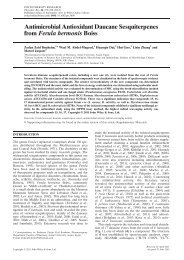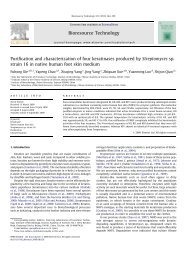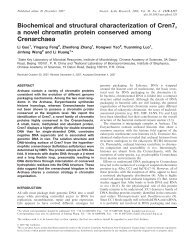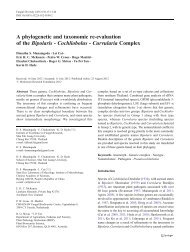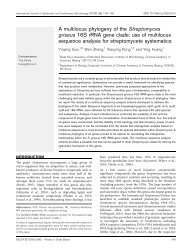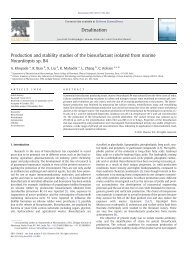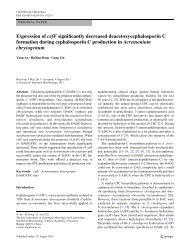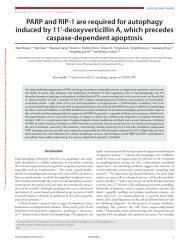Cdc42 regulates microtubule-dependent Golgi positi... - ResearchGate
Cdc42 regulates microtubule-dependent Golgi positi... - ResearchGate
Cdc42 regulates microtubule-dependent Golgi positi... - ResearchGate
You also want an ePaper? Increase the reach of your titles
YUMPU automatically turns print PDFs into web optimized ePapers that Google loves.
Hehnly et al.<br />
Figure 4: Exogenous <strong>Golgi</strong> membranes bind permeabilized<br />
cells. A) NRK cells were mock-treated or permeabilized by a<br />
freeze/thaw cycle as indicated. Rat-liver <strong>Golgi</strong> particles were<br />
incubated with cytosol, GTPγS and an ATP-regenerating system,<br />
then labeled with bodipy-C5-ceramide (red) and added to the<br />
permeabilized cells at 37 ◦ C. The nuclei were labeled using<br />
DRAQ5 (blue). In two in<strong>dependent</strong> experiments, no exogenous<br />
membranes were found bound to intact cells (n = 20 cells)<br />
while an average of 0.6 membrane particles was observed<br />
per permeabilized cell (n = 19 cells). The bar represents 10 μm.<br />
B) Permeabilized Vero cells were incubated with rat-liver <strong>Golgi</strong><br />
membranes (red). The cells were fixed and the endogenous <strong>Golgi</strong><br />
membranes were decorated with a primate-specific antibody<br />
against giantin (green). The nuclei were labeled using DRAQ5<br />
(blue).<br />
nocodazole treatment greatly reduced the number of<br />
cell-associated exogenous <strong>Golgi</strong> particles (Figure 5C,D),<br />
indicating that binding to the permeabilized cells is indeed<br />
<strong>microtubule</strong> <strong>dependent</strong>. Although bodipy-C5-ceramidelabeled<br />
rat-liver <strong>Golgi</strong> membranes were used for the<br />
majority of these experiments, we obtained similar results<br />
with GFP-labeled <strong>Golgi</strong> membranes isolated from CHO<br />
cells (Figure S3A).<br />
Time-lapse microscopy (Figure 6A, Supporting Information<br />
Movies S1 and S2) revealed that the exogenous <strong>Golgi</strong><br />
membranes were not ‘captured’ statically to <strong>microtubule</strong>s,<br />
but instead underwent occasional movement. The motility<br />
Figure 5: Exogenous <strong>Golgi</strong> membranes undergo<br />
<strong>microtubule</strong>-<strong>dependent</strong> entry into permeabilized cells.<br />
A) Shown are confocal micrographs of NRK cells that were<br />
fixed at the indicated time-points relative to permeabilization<br />
and incubation. The cells were decorated with antibodies<br />
against the <strong>Golgi</strong> marker GM130 (green) and <strong>microtubule</strong>s (red).<br />
The nuclei were labeled using DRAQ5 (blue). B) Shown are<br />
confocal micrographs indicating actin distribution at the indicated<br />
time-points relative to the permeabilization and incubation.<br />
C) NRK cells were either mock-treated (control) or incubated with<br />
20 μM nocodazole before and after permeabilization. Rat-liver<br />
<strong>Golgi</strong> membranes (red) and cytosol were added to the cells,<br />
and cell-associated membranes were visualized by confocal<br />
microscopy. The bar represents 20 μm. D) NRK cells were<br />
treated as in (C) and the average number of <strong>Golgi</strong> particles per<br />
cell was determined from four in<strong>dependent</strong> experiments by blind<br />
counting with (n = 85 cells) or without (n = 111 cells) nocodazole<br />
treatment. The standard error is indicated by bars.<br />
1072 Traffic 2010; 11: 1067–1078






